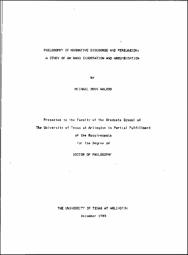
ATTENTION: The works hosted here are being migrated to a new repository that will consolidate resources, improve discoverability, and better show UTA's research impact on the global community. We will update authors as the migration progresses. Please see MavMatrix for more information.
Show simple item record
| dc.contributor.advisor | Longacre, Robert E. | |
| dc.contributor.author | Walrod, Michael Ross | |
| dc.date.accessioned | 2020-10-12T18:21:18Z | |
| dc.date.available | 2020-10-12T18:21:18Z | |
| dc.date.issued | 1983-12 | |
| dc.identifier.uri | http://hdl.handle.net/10106/29517 | |
| dc.description.abstract | This work applies the insights of textlinguistics to the study of normative or persuasive discourse. Although textlinguistics is already somewhat interdisciplinary in character, it was found to be too narrow to account for normative discourse, and had to be expanded to include further considerations of cultural phenomena, norms, and the relations of these to the theory of knowledge structures. In addition to the above, there are five major contributions of this study: (1) It shows how norms and knowledge structures play a part in the process of persuasion, and also redefines persuasion as including either the changing or the perpetuating of norms or knowledge structures. (2) It clarifies the logic of normative discourse, and demonstrates that there is not a radical difference between normative and empirical reasoning. (3) It explicates the often observed phenomenon of cultural differences in cognitive processes, since this has a bearing on cultural differences in modes of argumentation and persuasion. The cause of much of the observed difference has not been shown to be a genetic difference, or a 'pre-logical mentality', or an inherent inability to think analytically or abstractly. Rather, it appears to be the relative prevalence of an oral or a literate tradition, and the cognitive inclinations fostered by each. (4) It describes the notional and surface structure of normative discourse in Ga'dang. This is a step toward a more general theory of normative discourse. (5) It identifies a scale of normativity, along which discourse types and discourse features can be ranked according to their normative force of persuasive impact. Many of the persuasive strategies and surface structures of Ga'dang normative discourse were ranked on this scale. This work is a step toward filling a major void in textlinguistics today, namely the lack of analysis of normative or persuasive texts. It is also a step toward understanding the apparently different logical or cognitive processes involved in persuasion in different cultural groups. | en_US |
| dc.language.iso | en_US | en_US |
| dc.publisher | University of Texas at Arlington | en_US |
| dc.subject | Language | en_US |
| dc.subject | Literature and linguistics | en_US |
| dc.title | PHILOSOPHY OF NORMATIVE DISCOURSE AND PERSUASION: A STUDY OF GA'DANG EXHORTATION AND ARGUMENTATION | en_US |
| dc.type | Dissertation | en_US |
| thesis.degree.department | Humanities | |
| thesis.degree.name | Doctor of Philosophy in Humanities | |
Files in this item
- Name:
- Philosophy of Normative Discourse ...
- Size:
- 9.476Mb
- Format:
- PDF
- Description:
- PDF
This item appears in the following Collection(s)
Show simple item record


